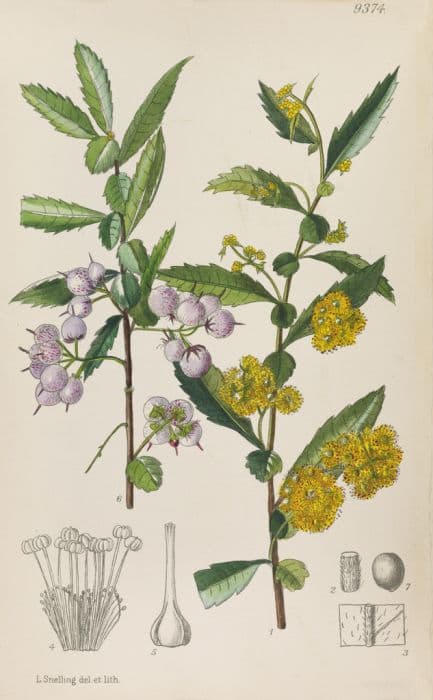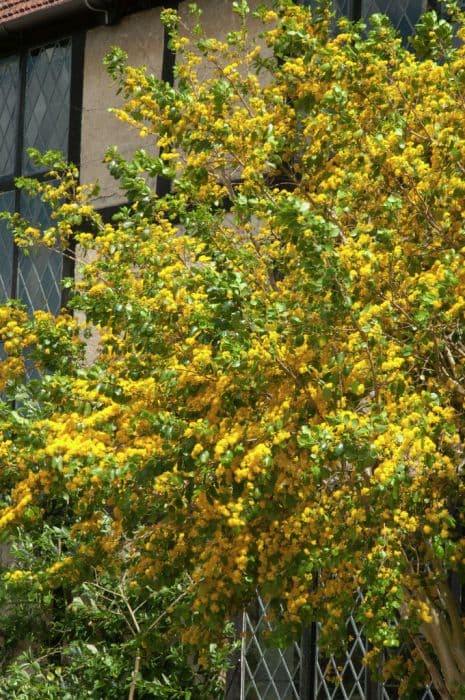Black Pussy Willow Salix gracilistyla 'Melanostachys' (m)

ABOUT
The plant known as Black Pussy Willow is a decorative species prized mainly for its unique and attractive catkins. These catkins are the standout feature of the plant, appearing in early spring. The male catkins are particularly impressive, with a dark purple or almost black hue, and they are covered with fine, silken hairs that give them a soft, fluffy appearance, reminiscent of tiny cat's paws. The contrast between these dark catkins and the bright yellow anthers that appear as they mature is quite striking. The foliage of the Black Pussy Willow consists of slender leaves that exhibit a lush, green color during the growing season. As with other willows, the leaves tend to have a slightly elongated shape, elegantly tapering to a point. The texture of the leaves is generally smooth, with a fine vein pattern that may be appreciated upon closer inspection. The bark of this plant is also a notable characteristic. It typically has a rough texture and can range in color from grey to brown. As the plant matures, the bark may develop a furrowed appearance that adds to its ornamental value. Given the right conditions, the Black Pussy Willow can produce a substantial number of catkins and leaves, creating a dense and visually appealing display. The combination of its unique catkins, pleasing foliage, and distinctive bark makes it a favored choice in gardens where a striking early spring interest is desired.
About this plant
 Names
NamesFamily
Salicaceae
Synonyms
Black Pussy Willow, Japanese Black Willow
Common names
Salix gracilistyla 'Melanostachys'
 Toxicity
ToxicityTo humans
The plant in question is commonly known as Black Pussy Willow. Black Pussy Willow is not considered highly toxic to humans. There is no well-documented evidence of significant toxicity from ingestion of this willow species. However, as with many plants, individual parts such as leaves, stems, or bark may cause mild stomach upset if ingested due to the presence of salicylates, which are related to aspirin. It's generally advised to avoid eating any part of ornamental plants due to potential individual sensitivities or unexpected allergic reactions.
To pets
Black Pussy Willow is generally not considered highly toxic to pets either. While the exact level of toxicity can vary among different species of willows, most willows contain salicylates, which can cause mild gastrointestinal upset if ingested in large quantities. Symptoms of ingestion in pets could include vomiting, diarrhea, or drooling. As a precaution, it is recommended to prevent pets from eating plants and to monitor them for any signs of distress after plant ingestion.
 Characteristics
CharacteristicsLife cycle
Perennials
Foliage type
Deciduous
Color of leaves
Green
Flower color
Black
Height
6 feet (1.83 meters)
Spread
5 feet (1.52 meters)
Plant type
Shrub
Hardiness zones
5
Native area
Japan
Benefits
 General Benefits
General Benefits- Ornamental value: Adds visual interest to gardens with its unique black catkins and red-anthered flowers in early spring.
- Seasonal interest: Provides early spring interest, one of the first shrubs to bloom after winter.
- Wildlife habitat: Offers food and shelter for birds and beneficial insects.
- Erosion control: Stabilizes soil and controls erosion, particularly effective along riverbanks and in wet areas.
- Adaptability: Tolerates a wide range of soil types and conditions, including wet and poorly drained soils.
- Fast growth: Quickly establishes and grows, making it useful for planting schemes that require rapid coverage or screening.
- Low maintenance: Requires minimal care once established, making it a good choice for low-maintenance landscaping.
- Hardiness: Survives in cold climates, showing resistance to frost and harsh weather conditions.
 Medical Properties
Medical Properties- This plant is not used for medical purposes.
 Air-purifying Qualities
Air-purifying QualitiesThis plant is not specifically known for air purifying qualities.
 Other Uses
Other Uses- The Black Pussy Willow's flexible branches are often used in basketry and weaving, providing material for a variety of handcrafted goods.
- The catkins of the Black Pussy Willow can be used for decorative purposes in floral arrangements, adding a unique texture and visual interest.
- As a natural dye, the tannins found in the bark of the Black Pussy Willow can be extracted to produce colors for textile dyeing.
- The plant is sometimes utilized in educational settings to study plant biology and the process of pollination, due to its prominent catkins and early bloom time.
- The wood of the Black Pussy Willow is suitable for crafting small wooden items like tool handles, due to its strength and pliability.
- In landscape design, the plant's striking appearance when the catkins emerge makes it useful as a focal point in winter gardens.
- The branches can be shaped into living sculptures or fences through a practice known as coppicing, creating living art within a garden.
- The dried branches and twigs can serve as kindling or as material for barbecue wood chips, offering a natural burnable resource.
- Creative arts use the catkins and branches for making wreaths and other decorative items, especially in rustic or natural-themed decor.
- In bonsai, the Black Pussy Willow can be trained to form miniature tree landscapes, tapping into the plant's natural aesthetic properties.
Interesting Facts
 Feng Shui
Feng ShuiThe Black Pussy Willow is not used in Feng Shui practice.
 Zodiac Sign Compitability
Zodiac Sign CompitabilityThe Black Pussy Willow is not used in astrology practice.
 Plant Symbolism
Plant Symbolism- Resilience and Strength: The Salix gracilistyla 'Melanostachys', commonly known as the Black Pussy Willow, has the symbolic meaning of resilience and strength due to its ability to thrive in various soil conditions and withstand harsh climates.
- Flexibility: Pussy Willows, in general, are symbols of flexibility as their branches are pliable and can bend without breaking, representing the ability to adapt to life's circumstances.
- Renewal and Hope: As one of the first plants to bloom at the end of winter, the Black Pussy Willow is often associated with renewal and the hope that comes with the arrival of spring.
- Protection: In some cultures, willow branches have been used as charms to ward off evil spirits or negativity, symbolizing protection and safety.
 Water
WaterThe Black Pussy Willow should be watered deeply, ensuring water reaches the roots, approximately once a week during active growth, but frequency should be adjusted according to weather conditions and soil moisture levels. A rough estimate is to provide about 1.5 gallons per watering for a young shrub, increasing the amount as the plant matures and its root system expands. In particularly hot or windy weather, the plant may require more frequent watering to prevent stress. During winter dormancy, water less frequently, only to prevent the soil from completely drying out.
 Light
LightThe Black Pussy Willow thrives in full sun to partial shade, preferring a location where it can receive at least six hours of direct sunlight per day. Plants situated in too much shade may become leggy and produce fewer catkins, so an optimal spot would be one where they are exposed to the morning sun and have some protection from the intense afternoon sun, if necessary.
 Temperature
TemperatureThe Black Pussy Willow is hardy and can withstand temperatures as low as -20 degrees Fahrenheit, but it grows best when the temperature is between 35 and 75 degrees Fahrenheit. It can survive brief periods of higher temperatures, though prolonged heat can cause stress, especially if accompanied by drought conditions.
 Pruning
PruningPruning the Black Pussy Willow is essential for maintaining its shape and encouraging the growth of the attractive catkins for which it is prized. The best time to prune is in late winter or early spring before new growth starts. Remove any dead or damaged branches, thin out overcrowded areas, and shape the tree as desired. Pruning can be done annually, focusing on the vigorous shoots that have grown in the previous year.
 Cleaning
CleaningAs needed
 Soil
SoilThe Black Pussy Willow requires moist, well-drained soil with a pH range of 6.0 to 7.0. A soil mix that combines garden loam, peat moss, and perlite in equal parts would be ideal to provide the necessary drainage and aeration while maintaining moisture. Regular mulching can help to retain soil moistness and provide organic nutrients.
 Repotting
RepottingGenerally, the Black Pussy Willow should be repotted every 2 to 3 years. As a fast-growing plant, it may outgrow its container within this period. Repotting in early spring is typically best, allowing the plant to establish in the new soil before the growing season.
 Humidity & Misting
Humidity & MistingBlack Pussy Willow thrives best in environments with moderate to high humidity levels. It does not require overly humid conditions but should not be subjected to very dry air either. Average room humidity or slightly higher is sufficient for healthy growth.
 Suitable locations
Suitable locationsIndoor
Ensure bright indirect light, consistent moisture, and cool room temperature.
Outdoor
Plant in moist area with full sun to partial shade exposure.
Hardiness zone
4-8 USDA
 Life cycle
Life cycleSalix gracilistyla 'Melanostachys', commonly known as the Black Pussy Willow, begins its life as a dormant seed, which, when conditions are right, germinates in moist soil. The seedling emerges and develops into a young plant, growing roots, shoots, and leaves, and eventually becoming a sapling. As it matures, the Black Pussy Willow forms a woody stem and distinctive narrow leaves; it reaches sexual maturity and begins to produce flowers, with male plants featuring the notable black catkins for which they are named. Pollination occurs typically with the help of wind, and seeds are produced and dispersed in the environment, completing the reproductive cycle. The plant continues to grow and expand through vegetative propagation, such as root sprouts or cuttings, increasing its size and spread over the years. The Black Pussy Willow can live for several decades, after which it dies and decomposes, returning nutrients to the soil and supporting the growth of new plants.
 Propogation
PropogationPropogation time
Early Spring
The most popular method of propagation for the black pussy willow (Salix gracilistyla 'Melanostachys') is through hardwood cuttings. This is done during the plant's dormancy period, typically in late winter or early spring before the buds start to swell. The process involves taking 6 to 8-inch (15 to 20 cm) lengths of one-year-old wood. Each cutting should have several nodes, from which new shoots and roots will emerge. These cuttings are then inserted into moist soil or a potting mix with at least two-thirds of their length buried. To encourage rooting, the top end of the cutting is often dipped in a rooting hormone before being planted. The cuttings should be kept in a cool but frost-free environment until established, after which they can be transplanted to their final location.









